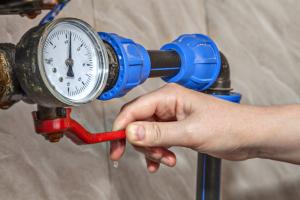Boost Your Home's Water Pressure: Practical Tips & Solutions

-
Quick Links:
- Introduction
- Understanding Water Pressure
- Common Causes of Low Water Pressure
- Measuring Your Water Pressure
- Quick Fixes for Low Water Pressure
- Permanent Solutions to Increase Water Pressure
- Case Studies: Real-Life Examples
- Expert Insights
- Conclusion
- FAQs
Introduction
Water pressure is an essential aspect of any home plumbing system. Low water pressure can lead to frustrating experiences, especially when taking a shower or using appliances like dishwashers and washing machines. In this comprehensive guide, we will explore effective strategies to increase water pressure in your home, ensuring you enjoy a consistent and powerful water flow.
Understanding Water Pressure
Water pressure is the force that pushes water through your plumbing system. It is measured in pounds per square inch (psi) and typically ranges from 40 to 60 psi for residential homes. Adequate water pressure is crucial for the proper functioning of plumbing fixtures and appliances.
Why Water Pressure Matters
- Improves shower experience
- Enhances appliance performance
- Ensures efficient water use
- Reduces the risk of plumbing issues
Common Causes of Low Water Pressure
Identifying the root cause of low water pressure is the first step in addressing the problem. Here are some common culprits:
- Clogged Pipes: Mineral buildup or debris can restrict water flow.
- Pressure Regulator Malfunction: A faulty pressure regulator can lead to inconsistent water pressure.
- Leaks in the System: Water leaks can significantly impact pressure levels.
- Aging Plumbing: Older pipes may degrade and restrict water flow.
- Municipal Supply Issues: Sometimes, low water pressure originates from the city’s water supply.
Measuring Your Water Pressure
Before making any adjustments, it's essential to measure your current water pressure. Here’s how to do it:
Tools You Will Need:
- Water pressure gauge
- Garden hose or faucet
Step-by-Step Guide:
- Attach the water pressure gauge to an outdoor faucet or hose bib.
- Turn on the faucet fully and note the reading on the gauge.
- If the reading is below 40 psi, you might need to increase your water pressure.
Quick Fixes for Low Water Pressure
Sometimes, simple actions can substantially improve your water pressure. Here are quick fixes to try:
- Clean Aerators and Showerheads: Remove and soak these fixtures in vinegar to dissolve mineral deposits.
- Check for Leaks: Inspect your plumbing for visible leaks and repair them promptly.
- Adjust Pressure Regulator: If your home has a pressure regulator, check its settings and adjust if necessary.
Permanent Solutions to Increase Water Pressure
If quick fixes do not suffice, consider these more permanent solutions:
1. Upgrade Your Pipes
Replacing old, narrow pipes with larger diameter pipes can significantly improve water pressure.
2. Install a Water Pressure Booster
A water pressure booster pump can be installed to increase pressure throughout your home.
3. Replace Pressure Regulator
If your pressure regulator is old or malfunctioning, replacing it can restore adequate water pressure.
4. Adjust Municipal Supply Pressure
Contact your local water provider to inquire about increasing the supply pressure if you suspect it is too low.
Case Studies: Real-Life Examples
Here are a few case studies showcasing successful water pressure improvements:
Case Study 1: The Smith Family
The Smith family experienced low water pressure after moving into an older home. By cleaning the aerators and replacing corroded pipes, they achieved a noticeable increase in pressure.
Case Study 2: The Johnsons
After installing a pressure booster pump, the Johnsons eliminated inconsistent water pressure, enhancing their shower and dishwasher performance.
Expert Insights
We consulted plumbing experts for their insights on maintaining optimal water pressure:
- Regular Maintenance: Perform routine checks on your plumbing system to catch issues early.
- Know Your Water Source: Understanding whether your supply is from a well or municipal source can influence your pressure management strategy.
Conclusion
Improving water pressure in your home can drastically enhance your daily life. By understanding the causes of low water pressure and implementing the right solutions, you can ensure a consistent and enjoyable flow of water. Whether through quick fixes or more permanent installations, the goal remains the same: to experience the comfort of high water pressure.
FAQs
- What is considered low water pressure? Low water pressure is typically defined as below 40 psi.
- How can I tell if my water pressure is too low? If showers are weak or appliances are not functioning correctly, you may have low pressure.
- Can I increase water pressure myself? Yes, many fixes like cleaning aerators or checking for leaks can be done DIY.
- What should I do if I suspect a leak? Contact a plumber to inspect and repair any leaks promptly.
- Is a water pressure booster pump worth it? If you consistently face low pressure, a booster pump can be a great investment.
- How often should I check my water pressure? It's a good idea to check your water pressure at least once a year.
- Can my water pressure be too high? Yes, excessively high water pressure can damage your plumbing system.
- Are there any health risks associated with low water pressure? Generally, low water pressure is a convenience issue rather than a health risk.
- What tools do I need to measure water pressure? A water pressure gauge is the primary tool needed.
- How do pressure regulators work? Pressure regulators maintain consistent water pressure by adjusting the flow as needed.
Random Reads